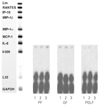1. Kiss M, Kemeny L, Gyulai R, Michel G, Husz S, Kovacs R, Dobozy A, Ruzicka T. Effects of the neuropeptides substance P, calcitonin gene-related peptide and α-melanocyte-stimulating hormone on the IL-8/IL-8 receptor system in a cultured human keratinocyte cell line and dermal fibroblasts. Inflammation. 1999. 23:557–567.
2. Bartold PM, Kylstra A, Lawson R. Substance P. An Immunohistochemical and Biochemical Study in Human Gingival Tissues. A Role for Neurogenic Inflammation? J Periodontol. 1994. 65:1113–1121.

3. Rameshwar P, Gascon P. Induction of negative hematopoietic regulators by neurokinin-A in bone marrow stroma. Blood. 1996. 88:98–106.

4. Baggiolini M, Walz A, Kunkel SL. Neutrophil-activating peptide-1/Interleukin 8, a novel cytokine that activates neutrophils. J Clin Invest. 1989. 84:1045–1049.

5. Kent LW, Dyken RA, Rahemtulla F, Allison AC, Michalek SM. Effects of
in vitro passage of healthy human gingival fibroblasts on cellular morphology and cytokine expression. Arch Oral Biol. 1996. 41:263–270.

6. Guo CJ, Lai JP, Luo HM, Douglas SD, Ho WZ. Substance P up-regulates macrophage inflammatory protein-1β expression in human T lymphocytes. J Neuroimmunol. 2002. 131:160–167.

7. Huang GTJ, Potente AP, Kim JW, Chugal N, Zhang X. Increased interleukin-8 espression in inflamed human dental pulps. Oral Surg Oral Med Oral Pathol Oral Radiol Endod. 1999. 88:214–220.
8. Fitzgerald JE, Kreutzer DL. Localization of Interleukin-8 in human gingival tissues. Oral Microbiol Immunol. 1996. 10:297–303.

9. Larsen CG, Anderson AO, Appella E, Oppenheim JJ, Matsushima K. The neutrophil-activating protein (NAP-1) is also chemotactic for T lymphocytes. Science. 1989. 243:1464–1466.

10. Peveri P, Walz A, Dewald B, Baggiolini M. A novel neutrophil activating factor produced by human mononuclear phagocytes. J Exp Med. 1988. 167:1547–1559.

11. Cuesta MC, Quintero L, Pons H, Suarez-Roca H. Substance P and calcitonin gene-related peptide increase IL-1β, IL-6 and TNFα secretion from human peripheral blood mononuclear cells. Neurochem Int. 2002. 40:301–306.

12. Park SH, Hsiao GYW, Huang GTJ. Role of substance P and calcitonin gene-related peptide in the regulation of interleukin-8 and monocyte chemotactic protein-1 expression in human dental pulp. Int Endod J. 2004. 37:185–192.

13. Bordin S, Narayanan S, Reddy J, Cleveland D, Page RC. Fibroblast subtypes in the periodontium. J Periodont Res. 1984. 19:642–644.

14. McCulloch CAG, Bordin S. Role of fibroblast subpopulations in periodontal physiology and pathology. J Periodont Res. 1991. 26:144–154.

15. Heyeraas KJ, Berggreen E. Interstitial fluid pressure in normal and inflamed pulp. Crit Rev Oral Biol Med. 1999. 10(3):328–336.

16. Berggreen E, Heyeraas KJ. Effect of the sensory neuropeptide antagonists h-CGRP((8-37)) and SR 140.33 on pulpal and gingival blood flow in ferrets. Arch Oral Biol. 2000. 45(7):537–542.

17. Fristad I, Kvinnsland IH, Jonsson R, Heyeraas KJ. Effect of intermittent long-lasting electrical tooth stimulation on pulpal blood flow and immunocompetent cells: a hemodynamic and immunohistochemical study in young rat molars. Exp Neurol. 1997. 146(1):230–239.

18. Fristad I, Heyeraas KJ, Kwinnsland IH, Jonsson R. Recruitment of immunocompetent cells after dentinal injuries in innervated and denervated young rat molars: an innunohistochemcal study. J Histochem Cytochem. 1995. 43(9):871–879.

19. Bongenhielm U, Haegerstrand A, Theodorsson E, Fried K. Effect of neuropeptides on growth of cultivated rat molar pulp fibroblasts. Regul Pept. 1995. 60(2-3):91–98.

20. Patel T, Park SH, Lin LM, Chiappelli F, Huang GTJ. Substance P induces interleukin-8 secretion from human dental pulp cells. Oral Surg Oral Med Oral Pathol Oral Radiol Endod. 2003. 96:478–485.

21. Ansel JC, Armstrong CA, Song I, Quinlan KL, Olerud JE, Caughman SW, Bunnett NW. Interaction of the skin and nervous system. J Investig Dermatol Symp Proc. 1997. 2(1):23–26.
22. Raap T, Justen HP, Miller LE, Cutolo M, Scholmerich J, Straub RH. Neurotransmitter modulation of interleukin 6(IL-6) and IL-8 secretion of synovial fibroblasts in patients with rheumatoid arthritis compared to osteoarthritis. J Rheumatol. 2000. 27:2558–2565.
23. Detmers PA, Lo SK, Olsen-Egbert E, Walz A, Baggiolini M, Cohn ZA. Neutrophil-activating protein 1/interleukin 8 stimulates the binding activity of the leukocyte adhesion receptor CD11b /CD18 on human neutrophils. J Exp Med. 1990. 171:1155–1162.

24. Rot A. Neutrophil attractant/activation protein-1(interleukin-8) induces
in vitro neutrophil migration by haptotactic mechanism. Eur J Immunol. 1993. 23:303–306.

25. Takashiba S, Takigawa M, Takahashi K, Myokai F, Nishimura F, Chihara T, Kurihara H, Nomura Y, Murayama Y. Interleukin-8 is a major neutrophil chemotactic factor derived from cultured human gingival fibroblasts stimulated with interleukin-1β or tumor necrosis factor alpha. Infection and Immunity. 1992. 60:5253–5258.





 PDF
PDF ePub
ePub Citation
Citation Print
Print





 XML Download
XML Download